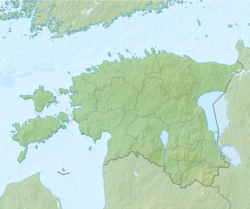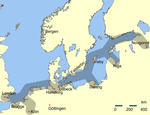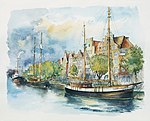world.wikisort.org - Estonia
Pärnu (Estonian pronunciation: [ˈpærˑnu]) is the fourth largest city in Estonia. Situated in southwest Estonia, Pärnu is located 128 kilometres (80 mi) south of the Estonian capital, Tallinn, and 176 kilometres (109 mi) west of Estonia's second largest city, Tartu. The city sits off the coast of Pärnu Bay, an inlet of the Gulf of Riga, which is a part of the Baltic Sea. In the city, the Pärnu River drains into the Gulf of Riga.
This article includes a list of general references, but it lacks sufficient corresponding inline citations. (February 2022) |
Pärnu
Pärnu linn City of Pärnu | |
|---|---|
City | |
Pärnu | |
 Flag  Coat of arms | |
| Coordinates: 58°23′N 24°30′E | |
| Country | Estonia |
| County | Pärnu County |
| Municipality | Pärnu |
| Founded | 1251 |
| Area | |
| • Total | 32.22 km2 (12.44 sq mi) |
| Elevation | 10 m (30 ft) |
| Population (2022)[1] | |
| • Total | 40,228 |
| • Rank | 4th |
| • Density | 1,200/km2 (3,200/sq mi) |
| Ethnicity | |
| • Estonians | 83% |
| • Russians | 12% |
| • other | 5% |
| Time zone | UTC+2 (EET) |
| • Summer (DST) | UTC+3 (EEST) |
| Area code | (+372) 44 |
| Vehicle registration | F |
Pärnu is a popular summer holiday resort town among Estonians with many hotels, restaurants and large beaches. The city is served by Pärnu Airport.
History

Perona (German: Alt-Pernau, Estonian: Vana-Pärnu), which was founded by the bishop of Ösel–Wiek c. 1251, suffered heavily under pressure of the concurrent town, and was finally destroyed c. 1600. Another town, Embeke (later German: Neu-Pernau, Estonian: Uus-Pärnu) was founded by the Livonian Order, who began building an Ordensburg nearby in 1265. The latter town, then known by the German name of Pernau, was a member of the Hanseatic League and an important ice-free harbor for Livonia. The Polish–Lithuanian Commonwealth took control of town between 1560 and 1617; the Poles and Lithuanians fought the Swedes nearby in 1609. Sweden took control of the town during the 16th-century Livonian War as part of Swedish Livonia, although it was not formally ceded by Poland-Lithuania until the 1660 Treaty of Oliva. Sweden then lost Livonia to the Russian Empire in the 1710 Capitulation of Estonia and Livonia and the 1721 Treaty of Nystad, following the Great Northern War. It belonged to the Imperial Russian Governorate of Livonia until 1917, when it was transferred to the short-lived Autonomous Governorate of Estonia. The city is occasionally referred to as Pyarnu, an incorrect reverse-transliteration from the Russian Пярну.
The town became part of independent Estonia in 1918 following World War I and the Estonian War of Independence.
The city was occupied by the Soviet Red Army along with the rest of Estonia in 1940 during World War II, and its German population fled the town. It was briefly occupied by Germany from 1941 until 1944 before it was reoccupied by the Soviet Union during its counteroffensives. Pärnu then continued as being part of the Estonian Soviet Socialist Republic from 1944 to 1991, when Estonia restored its independence.
During the Great Northern War, the University of Dorpat (Tartu) was relocated to Pärnu from 1699 to 1710. The university has still maintained a branch campus in Pärnu to this day (1,000 students in the 2004/2005 school year).[2]
Geography
Districts of Pärnu
There are seven districts in Pärnu: Ülejõe, Rääma, Vana-Pärnu, Kesklinn, Rannarajoon, Eeslinn and Raeküla.[3]
Climate
Pärnu lies within the temperate humid continental climate zone.
| Climate data for Pärnu (normals 1991–2020, extremes 1842–present) | |||||||||||||
|---|---|---|---|---|---|---|---|---|---|---|---|---|---|
| Month | Jan | Feb | Mar | Apr | May | Jun | Jul | Aug | Sep | Oct | Nov | Dec | Year |
| Record high °C (°F) | 9.0 (48.2) |
8.3 (46.9) |
18.1 (64.6) |
26.2 (79.2) |
31.2 (88.2) |
32.6 (90.7) |
34.1 (93.4) |
33.4 (92.1) |
28.0 (82.4) |
22.4 (72.3) |
12.6 (54.7) |
10.3 (50.5) |
34.1 (93.4) |
| Average high °C (°F) | −0.8 (30.6) |
−1 (30) |
3.0 (37.4) |
10.2 (50.4) |
16.7 (62.1) |
20.2 (68.4) |
23.0 (73.4) |
21.8 (71.2) |
16.6 (61.9) |
9.9 (49.8) |
4.3 (39.7) |
1.1 (34.0) |
10.4 (50.7) |
| Daily mean °C (°F) | −3.0 (26.6) |
−3.7 (25.3) |
−0.5 (31.1) |
5.4 (41.7) |
11.4 (52.5) |
15.4 (59.7) |
18.3 (64.9) |
17.2 (63.0) |
12.5 (54.5) |
6.8 (44.2) |
2.2 (36.0) |
−0.9 (30.4) |
6.8 (44.2) |
| Average low °C (°F) | −5.5 (22.1) |
−6.6 (20.1) |
−3.7 (25.3) |
1.2 (34.2) |
6.1 (43.0) |
10.7 (51.3) |
13.6 (56.5) |
12.8 (55.0) |
8.6 (47.5) |
3.8 (38.8) |
0.0 (32.0) |
−3.1 (26.4) |
3.2 (37.8) |
| Record low °C (°F) | −34.8 (−30.6) |
−34.3 (−29.7) |
−28.5 (−19.3) |
−19.7 (−3.5) |
−5.3 (22.5) |
−0.1 (31.8) |
3.4 (38.1) |
2.6 (36.7) |
−4.7 (23.5) |
−10.9 (12.4) |
−22.2 (−8.0) |
−34.5 (−30.1) |
−34.8 (−30.6) |
| Average precipitation mm (inches) | 61 (2.4) |
49 (1.9) |
43 (1.7) |
40 (1.6) |
39 (1.5) |
78 (3.1) |
74 (2.9) |
84 (3.3) |
61 (2.4) |
83 (3.3) |
73 (2.9) |
71 (2.8) |
761 (30.0) |
| Average precipitation days (≥ 1.0 mm) | 12 | 9 | 10 | 8 | 7 | 9 | 10 | 10 | 11 | 12 | 14 | 14 | 125 |
| Average relative humidity (%) | 88 | 87 | 81 | 73 | 68 | 73 | 75 | 78 | 82 | 86 | 89 | 89 | 81 |
| Mean monthly sunshine hours | 38.8 | 69.6 | 148.2 | 210.1 | 300.3 | 293.5 | 306.4 | 258.6 | 172.8 | 95.5 | 36.5 | 24.3 | 1,950.2 |
| Source: Estonian Weather Service (precipitation days 1971–2000)[4][5][6][7][8][9] | |||||||||||||
Waterbodies
Pärnu River, Sauga River, Reiu River, Pärnu Moat, Pärnu Bay.
Pärnu Moat was previously a part of Pärnu Fortress. Nowadays, it is mainly used as a venue for different events.[10]
Demography
Population change
| Year | 1881 | 1897 | 1922 | 1934 | 1959 | 1970 | 1979 | 1989 | 2000 | 2011 | 2012 | 2017 | 2022 |
|---|---|---|---|---|---|---|---|---|---|---|---|---|---|
| Population | 12,966 | 12,898 | 18,499 | 20,334 | 22,367 | 50,224 | 54,051 | 53,885 | 45,500 | 39,728 | 40,401 | 40,700 | 40,228 |
Ethnic groups
| Nationality | 2000 census | 2011 census[11] | ||
|---|---|---|---|---|
| Number | % | Number | % | |
| Estonians | 36,112 | 79.37 | 33,000 | 83.07 |
| Russians | 6,951 | 15.28 | 5,076 | 12.78 |
| Ukrainians | 966 | 2.12 | 671 | 1.69 |
| Finns | 331 | 0.73 | 254 | 0.64 |
| Belarusians | 297 | 0.65 | 179 | 0.45 |
| Total | 45,500 | 39,728 | ||
| Language | 2000 census[12] | 2011 census[11] | ||
|---|---|---|---|---|
| Number | % | Number | % | |
| Estonian | 35,928 | 78.96 | 32,762 | 82.47 |
| Russian | 8,360 | 18.37 | 6,263 | 15.77 |
| Ukrainian | 426 | 0.94 | 245 | 0.62 |
| Finnish | 163 | 0.36 | 129 | 0.33 |
| Belarusian | 100 | 0.22 | 32 | 0.08 |
| Total | 45,500 | 39,728 | ||
Economy

Today Pärnu is an economically balanced region with a comprehensive range of industries. Foreign investments and new businesses with up-to-date technologies have enhanced job creation and higher competitiveness of the businesses in the world markets. Several enterprises of Pärnu region stand out as the best in Estonia.
Significant flows of exports from Pärnu region and South-Estonia pass through the Port of Pärnu which lies at the mouth of the Pärnu River. In recent years, the port has developed into an important regional harbour for south-western and southern Estonia. Pärnu's fame as a rehabilitation and holiday resort dates back to the middle of the 19th century. The foundation of the first bathing facility in 1838 is considered the birth date of Pärnu resort. Today Pärnu has all desirable qualities of a modern holiday resort – it has spas and rehabilitation centres, hotels, conference and concert venues, golf courses and tennis courts, restaurants and pubs. Long tradition of as a resort has made Pärnu well known in Finland and Scandinavian countries.
Tourism

The majority of the tourists in Pärnu are Finns, Swedes and Russians. German, Latvian, and Norwegian tourists have also become more common.
In 1837, a tavern near the beach was made into a bathing establishment. The establishment accommodated 5–6 bathrooms that provided hot seawater baths in summer and operated as a sauna in winter. The wooden building was burnt down in the course of World War I. In 1927, the present stone building of Pärnu Mud Baths was erected at the same site.
Since 1996 Pärnu has been known as Estonia's Summer Capital.[13][14]
Starting from 2015 the city of Pärnu hosts the annual Weekend Festival, the largest dance music festival in the Nordic and Baltic region. Stages are headlined by DJs from across the electronic dance music spectrum, with audiovisual support. Some of the past and upcoming artists to perform include Martin Garrix, David Guetta, Avicii, Steve Aoki, The Chainsmokers, Tiësto, Armin van Buuren, Hardwell, Robin Schulz, Afrojack, deadmau5, Knife Party, Desiigner and many more. Pärnu is also known for its seawall. According to legend, if a couple holds hands while journeying along the wall and kisses at its endpoint they will stay together forever.[15]
Gallery
- Endla Theatre
- Nikolai street with St. Elizabeth's Church
- Pärnu beach promenade
- Sunset in Pärnu beach.
Honorary citizens of Pärnu
- 1886 Konstantin Possiet
- 1901 Friedrich Fromhold Martens
- 1934 Konstantin Päts
- 2007 Neeme Järvi
- 2008 Valter Ojakäär
- 2009 Jüri Jaanson
Notable residents

- Gustav Fabergé, jeweller
- Johann Voldemar Jannsen, Estonian journalist and poet
- Lili Kaelas, archeologist
- Tõnis Kasemets, race-car driver who has competed in ChampCar and IMSA
- Paul Keres, chess grandmaster
- Lydia Koidula, poet
- Kaie Kõrb, prima ballerina
- Karin Luts, Estonian artist
- Friedrich Martens, lawyer
- Kaili Närep, actress
- David Oistrakh, violinist
- Liisa Pulk, actress
- Rasmus Rändvee, singer
- Salme Reek, actress
- Georg Wilhelm Richmann, German physicist
- Erika Salumäe, track bicycle racer
- David Samoylov, poet
- August Sang, poet
- Olev Siinmaa, architect
- David Shrayer-Petrov, poet, fiction writer, translator, medical scientist
- Maxim D. Shrayer, author and literary scholar
- Avo Sõmer, musicologist, music theorist, composer
- Kristin Tattar, athlete, disc golf world champion
Sister cities
 Pánd
Pánd
See also
- Pärnu Leht
References
- Population by sex, age and place of residence after the 2017 administrative reform, 1 January. Statistics Estonia.
- University of Tartu Pärnu College
- "LINNAOSADE JA -JAGUDE LÜHENDID". www.eki.ee (in Estonian). Retrieved 18 March 2020.
- "Climate normals-Temperature". Estonian Weather Service. Retrieved 1 February 2021.
- "Climate normals-Precipitation". Estonian Weather Service. Retrieved 1 February 2021.
- "Climate normals-Humidity". Estonian Weather Service. Retrieved 1 February 2021.
- "Climate normals-Sunshine". Estonian Weather Service. Retrieved 1 February 2021.
- "Rekordid" (in Estonian). Estonian Weather Service. Retrieved 19 March 2021.
- "Kliimanormid-Sademed, õhuniiskus" (in Estonian). Estonian Weather Service. Archived from the original on 22 February 2012. Retrieved 1 February 2021.
- "Pärnu moat, Estonia". Visitestonia.com. Retrieved 23 December 2020.
- "Statistika andmebaas - Vali tabel".
- "Statistika andmebaas - Vali tabel".
- suvepealinn
- "Short history – VisitPärnu.com". Archived from the original on 2016-03-03. Retrieved 2012-06-15.
- "Pärnu Seawall".
- Maxim D. Shrayer. Dunes of Happiness: Fifteen Summers in Estonia. Baltic Worlds (September 2013).
External links
- The Official Tourist Information Centre Foundation of Pärnu
- Parnu tour overview Archived 2006-09-07 at the Wayback Machine
- Sightseeing on Your own
- MERKO: 2010–2011 Pärnu moat and park area reconstruction, land reclamation and landscaping, with 6 photos
На других языках
[de] Pärnu
Pärnu (deutsch Pernau) ist eine estnische Hafenstadt mit 51.272 Einwohnern (2019) und ein wichtiges Seebad im gleichnamigen Kreis.- [en] Pärnu
[ru] Пярну
Пя́рну (эст. Pärnu), рус. Пернов, Пернау (нем. Pernau) — портовый город на юго-западе Эстонии с населением 40 700 жителей (2017), является четвёртым по величине и по численности населения городом в Эстонии.Другой контент может иметь иную лицензию. Перед использованием материалов сайта WikiSort.org внимательно изучите правила лицензирования конкретных элементов наполнения сайта.
WikiSort.org - проект по пересортировке и дополнению контента Википедии












